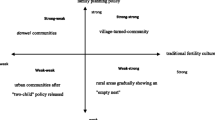Abstract
This article tests the hypothesis that in the Nepal Himalayas the Tibetan sociocultural system (fraternal polyandry) reduces aggregate fertility whereas the Hindu system maximizes by early and virtually universal monogamous marriage. It is shown that while fraternal polyandry does reduce aggregate fertility, the hypothesis that it would lead to a substantially lower fertility rate is false because the effects of fraternal polyandry are roughly balanced by the effects of postwidowhood celibacy among the Hindus.
Similar content being viewed by others
References
Bangham, C., and Sacherer, J. (1980). Fertility of Nepalese Sherpas at moderate altitudes: Comparison with high altitude data.Annals of Human Biology 7(4): 323–330.
Bista, D. (1972).The People of Nepal. Ratna Pustak Bhandar, Kathmandu, Nepal.
Davis, K., and Blake, J. (1956). Social structure and fertility: An analytical framework.Economic Development and Culture Change 43: 211–235.
Von Furer-Haimendorf, C. (1975).Himalayan Traders. John Murray, London.
Goldstein, M. (1976). Fraternal polyandry and fertility in a high Himalayan Valley in northwest Nepal.Human Ecology 4: 223–233.
Goldstein, M. (1981a). New perspectives on Tibetan fertility and population decline.American Ethnologist 8(4): 721–729.
Goldstein, M. (1981b). High altitude Tibetan population in the remote Himalaya: Social transformation and its demographic, economic and ecological consequences.Mountain Research Development 1(1): 5–18.
Goldstein, M. C., Tsarong, P., and Beall, C. M. (1983). High altitude hypoxia, culture and human fecundity/fertility: a comparative study.American Anthropologist 85(1).
Gupta, R. (1978). A comparative demographic study of the Sherpas of upper Khumbu (above 10,000 feet), Nepal and their migrant counterpart Kalimpong subdivision (3000–6000 feet). Darjeeling District, West Bengal, Culcutta, Biological Science Division of the Indian Statistical Institute.
Gupta, R. (1980). Altitude and demography among the Sherpas.Journal of Biosocial Science 12: 103–114.
Lang, S., and Lang, A. (1971). The Khunde hospital and a demographic survey of the upper Khumba, Nepal.New Zealand Medical Journal 74: 1–8.
Levine, N. (1977).The Nyinba: Population and Social Structure in a Polyandrous Society. Ph.D. dissertation, University of Rochester, New York.
Mandelbaum, D. (1974).Human Fertility in India. University of California Press, Berkeley.
Population Reference Bureau. (1980).1980 World Population Data Sheet. Population Reference Bureau, Washington, D. C.
Ross, J. L. (1981).Hindu and Tibetan Reproduction and Fertility in Northwestern Nepal: A Study of Population, Ecology and Economics. Ph.D. dissertation, Case Western Reserve University.
Tuldhar, J., Gubhaju, B., and Stoeckel, J. (1977).The Population of Nepal: Structure and Change. University of California, Center for South and Southeast Asian Studies, Berkeley.
Weitz, C., Pawson, J., Weitz, M., Lang, S., and Lang, A. (1978). Cultural factors affecting the demographic structure of a high altitude Nepalese population.Social Biology 25(3): 179–195.
Author information
Authors and Affiliations
Additional information
This paper is the result of research undertaken in Nepal from 1975–1977. Support was provided in part by a National Science Foundation Dissertation Improvement Grant (BNS 76-00670) and grants from the Graduate Alumni Fund, Case Western Reserve University.




